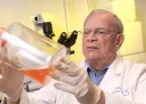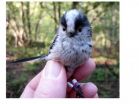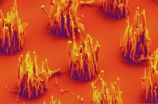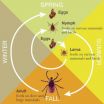(Press-News.org) What sort of leader are you? Do you think leading is all about a laser-like focus on the task, watching the bottom line and making sure everyone is doing what they should? Or is it about listening to your team, being open to ideas and perspectives, and inspiring them to find their own niche?
Distinctions between a task-oriented leader and a social-emotional leader have filled the pages of academic literature for more than a half-century. But recent research strongly suggests the distinction has a foundation in our brains—which allows us to be either analytical or empathetic, but not both at the same time—researchers at Case Western Reserve University report.
The managerial world has long held that a leader must be either one type or the other. But the presence of both capabilities in a normal brain suggests the opposite is true, the researchers argue in a study published online in the journal Frontiers in Human Neuroscience, at http://journal.frontiersin.org/Journal/10.3389/fnhum.2014.00114/full.
The failure of management and graduate schools and the business world at large to value and develop both capabilities results in damage ranging from inefficient operations to unethical decision-making, the researchers contend.
"In the '70s, business became focused on the return-on-investment and cash-flow, and this led to the elevation of financial wizards to demigod status in the '90s and resulted in the financial meltdown in 2007," said Richard Boyatzis, professor of organizational behavior at Case Western Reserve's Weatherhead School of Management and a study author.
"Those are the consequences of too narrow a focus by organizations on only the financial side," he said.
Boyatzis worked on the study with Anthony Jack, assistant professor of cognitive science at Case Western Reserve, and Kylie Rochford, a PhD student in organizational behavior.
A balanced leader
"The balanced leader switches fluidly between focusing on operations and the bottom line at one moment, and fostering a positive work environment and ethical insight the next," Jack said. "What the science is telling us is that the brain naturally supports this switching, but doesn't function so well when we blend the two modes."
Researchers found the brain contains what's called the "Task Positive Network (TPN)," which is analytical and task-oriented, and the "Default Mode Network (DMN)," which is empathetic and social.
Using functional magnetic resonance imaging (MRI) on dozens of subjects, Jack has shown the two networks tend to suppress one another when presented with technical or social problems to solve. The brain constantly cycles between the two networks while the subject is at rest. This see-sawing activity is stronger in people who are psychologically healthy and have higher IQ.
Jack also found that, when subjects employed both networks at the same time, the subject was typically being manipulative or anti-social rather than a more balanced thinker.
"Every normal brain contains both modes, with the flexibility to go to the right mode at the right time," Jack said. "In the business world right now, the emphasis is more on the task orientation of leaders rather than cultivating empathy. That is partly because it easier to assess task-oriented leadership."
But the long-term consequences of this cultural bias are damaging. "Emphasizing one side over the other is not the best way to promote good leadership," Jack said,
One-way thinking
Management research over decades shows each mode of thinking has advantages and downsides.
Being task-oriented leads to focus, solving problems and efficient execution of clearly defined objectives. That is desirable, Jack points out, when a surgeon is focused on being precise with an incision rather than on the pain the incision will cause.
But research has shown that focusing solely on completing tasks—or on the bottom line—squashes creativity, hinders ethical insight, openness and new ideas, and harms employee morale.
Being an empathetic leader can increase employee motivation and engagement, encourage creativity and is essential for ethical decision-making.
"Leaders are always trying to get things done through people, so it's important to pay attention to the relationships," Rochford said.
But a social-only focus results in a lack of attention to objectives, which is inefficient when the task requirements are clear and the goal is to execute them, Jack said.
Further, workers' perceptions of a leader swing with the circumstances. Past management studies show that workers perceive task-oriented bosses as effective when they have a clear job to get done, and poor leaders when they appear to focus only on short-run output.
Workers perceived bosses focused on work relationships as effective when they showed trust in the workers and were primarily concerned with developing workers' talents. But these same leaders were seen as ineffective when they seemed to be passive about a task at hand.
Historically off-target
"Since the 1940s, people have demonstrated the need in families, teams and management for two types of leaders: those task-oriented and the social/emotional/relationship leader," Boyatzis said.
But most approaches used to identify and develop effective leaders are misguided, he said, because "we confuse the ability to be effective in both by focusing on one."
Boyatzis said, for example, the usual step to becoming a school principal is to first be an assistant principal.
"The assistant principal focuses on tasks and operations and discipline within the school, which are often lousy preparation for relationship development," Boyatzis said. "But the role of the principal is to develop relationships with the parents and community."
Split leadership roles are common, from parenting to CEOs. "But the problem is, who covers both when one leaves?" Boyatzis said.
Finding a leader who is outstanding at both is rarer, but it is possible, Boyatzis said. "The fact we have these two distinct neural domains suggests it is possible to cultivate both sides, and we do see that in individuals," he said.
Cultivating both networks
The researchers say the challenge for education and leadership training is to help people cultivate both skill sets, so leaders can cycle fluidly between the two networks and better perceive when each mode of thinking is appropriate.
They suggest that organizations provide management candidates with coaching and training in both domains. They advise using simulations to allow leaders-in-training to practice moving back and forth between task-focused and social networks.
The candidates should also be required to follow a career path that invokes these networks differentially. For example, candidates may develop the DMN by splitting time on marketing projects and on training and developing people; and TPN by spending time in finance, information technologies and quality assurance.
In higher education, especially in graduate professional programs, coursework should be modified to insure teamwork in class assignments, field projects, service learning and internships, and there should be more integration of personal reflection on one's own behavior, values and impact on others, Boyatzis said.
The researchers are now devising experiments to investigate how people switch back and forth between the networks, according to analytical or social tasks they're presented. They are also investigating personality factors which relate to the individual differences in the tendency to use one network or the other for specific situations.
INFORMATION: END
Leaders are wired to be task-focused or team-builders, but can be both
2014-03-24
ELSE PRESS RELEASES FROM THIS DATE:
Want to survive the zombie apocalypse? This 'cologne' could be the key (video)
2014-03-24
WASHINGTON, March 24, 2014 — If you believe the doomsayers, a zombie apocalypse is coming, and you need to be prepared. On AMC's The Walking Dead, whose season finale airs Sunday, survivors are always worried about running out of bullets, arrows or even sharp sticks. But what if chemistry could help you get away from the flesh eaters? In the American Chemical Society's (ACS') latest Reactions video, we talk with chemist Raychelle Burks, Ph.D., who shares her recipe for a "death cologne" that might someday save you from the undead. The video is available at http://www.youtube.com/watch?v=SUEjmyisz7c.
INFORMATION:
Subscribe ...
Gene expression signature reveals new way to classify gum disease
2014-03-24
NEW YORK, NY (March 21, 2014) — Researchers at Columbia University Medical Center (CUMC) have devised a new system for classifying periodontal disease based on the genetic signature of affected tissue, rather than on clinical signs and symptoms. The new classification system, the first of its kind, may allow for earlier detection and more individualized treatment of severe periodontitis, before loss of teeth and supportive bone occurs. The findings were published recently in the online edition of the Journal of Dental Research.
Currently, periodontal disease is classified ...
Inherited mutated gene raises lung cancer risk for women, those who never smoked
2014-03-24
DALLAS – March 21, 2014 – People who have an inherited mutation of a certain gene have a high chance of getting lung cancer — higher, even, than heavy smokers with or without the inherited mutation, according to new findings by cancer researchers at UT Southwestern Medical Center. Although both genders have an equal risk of inheriting the mutation, those who develop lung cancer are mostly women and have never smoked, the researchers found.
People with the rare inherited T790M mutation of the epidermal growth factor receptor (EGFR) gene who have never smoked have a one-in-three ...
Researcher: Study on element could change ballgame on radioactive waste
2014-03-24
TALLAHASSEE, Fla. — Groundbreaking work by a team of chemists on a fringe element of the periodic table could change how the world stores radioactive waste and recycles fuel.
The element is called californium — Cf if you're looking at the Periodic Table of Elements — and it's what Florida State Professor Thomas Albrecht-Schmitt, the lead researcher on the project, calls "wicked stuff."
In carefully choreographed experiments, Albrecht-Schmitt and his colleagues found that californium had amazing abilities to bond and separate other materials. They also found it was extremely ...
Nasal spray delivers new type of depression treatment
2014-03-24
(Toronto) March 24, 2014 – A nasal spray that delivers a peptide to treat depression holds promise as a potential alternative therapeutic approach, research from the Centre for Addiction and Mental Health (CAMH) shows.
The study, led by CAMH's Dr. Fang Liu, is published online in Neuropsychopharmacology.
In a previous study published in Nature Medicine in 2010, Dr. Liu developed a protein peptide that provided a highly targeted approach to treating depression that she hopes will have minimal side effects. The peptide was just as effective in relieving symptoms when ...
Life hots up for British birds
2014-03-24
Climate change may be bad news for billions, but scientists at the University of Sheffield have discovered one unlikely winner – a tiny British bird, the long-tailed tit.
Like other small animals that live for only two or three years, these birds had until now been thought to die in large numbers during cold winters. But new research suggests that warm weather during spring instead holds the key to their survival.
The findings come from a 20-year study of long-tailed tits run by Professor Ben Hatchwell at the Department of Animal and Plant Sciences. The recent work ...
Biased sex ratios predict more promiscuity, polygamy and divorce in birds
2014-03-24
Birds in female-dominated populations are more likely to ditch and 'divorce' their mates while promiscuity increases in predominantly male environments, according to new research.
A joint study by the University of Sheffield and the University of Bath gives the first conclusive proof that rates of divorce and infidelity in birds are affected by the adult sex ratio of the population they live in – a theory previously discounted by biologists.
The study, which examined the pair bonding and mating behaviour of 197 different species of bird, found the divorce rate was higher ...
Recovering valuable substances from wastewater
2014-03-24
Not only plants, but also humans and animals need phosphorus, which is a building block of DNA. Many biological processes in our body can only take place if phosphorus atoms are also present. But farmers and industrial enterprises use so much of this element that soil is over-fertilized and waterways are contaminated.
This is where the experts of the German Phosphorus Platform DPP come in. As they have made it their aim to recover the phosphorus from the water, on the one hand in order to protect the environment and on the other to reutilize this valuable raw material ...
Researchers grow carbon nanofibers using ambient air, without toxic ammonia
2014-03-24
Researchers from North Carolina State University have demonstrated that vertically aligned carbon nanofibers (VACNFs) can be manufactured using ambient air, making the manufacturing process safer and less expensive. VACNFs hold promise for use in gene-delivery tools, sensors, batteries and other technologies.
Conventional techniques for creating VACNFs rely on the use of ammonia gas, which is toxic. And while ammonia gas is not expensive, it's not free.
"This discovery makes VACNF manufacture safer and cheaper, because you don't need to account for the risks and costs ...
Mice give ticks a free lunch
2014-03-24
(Millbrook, NY) People living in northern and central parts of the U.S. are more likely to contract Lyme disease and other tick-borne ailments when white-footed mice are abundant. Mice are effective at transferring disease-causing pathogens to feeding ticks. And, according to an in-press paper in the journal Ecology, these "super hosts" appear indifferent to larval tick infestations.
Drawing on 16 years of field research performed at the Cary Institute of Ecosystem Studies in Millbrook, New York, the paper found that white-footed mice with hundreds of larval ticks ...






